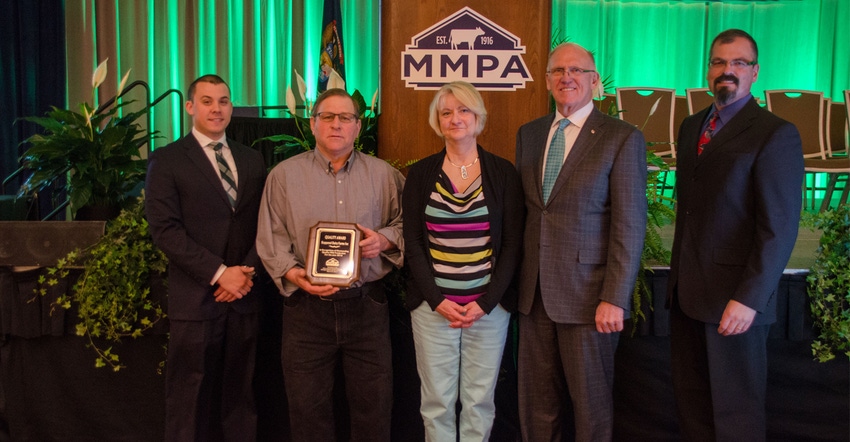April 6, 2017

Koppenol Dairy Farm, like the cream in its milk, rose to the top, earning accolades from Michigan Milk Producers, a member-owned and operated dairy cooperative serving about 2,000 dairy farmers in Michigan, Indiana, Ohio and Wisconsin.
Alan and Deborah Koppenol run the 195-cow dairy that claimed MMPA’s Top Quality Award at its annual meeting March 23 in Lansing.
With a somatic cell count (SCC) of 49,750 cells per milliliter, a pre-incubated bacteria count of 1,250 cells per milliliter and a raw bacteria count of 1,000 cells per milliliter, the Coopersville farm beat out all 1,167 MMPA members to achieve the highest-quality milk in fiscal year 2016.
Lower somatic cell and bacteria counts indicate better animal health and higher milk quality. MMPA members begin receiving premium payments and are eligible for quality awards for milk averaging less than 250,000 SCC.
In total, 512 quality awards were earned by MMPA members in 2016 — 38 of which were gold awards for members maintaining an SCC average of less than 100,000.
Since 1990, MMPA has recognized the farm that produces the highest-quality milk for the year. “It takes commitment by everyone on the farm to meet MMPA’s quality premium levels every month of the year,” says Dean Letter, MMPA director of member services.
The Koppenols’ milk averages 3.82% butterfat and 3.22% protein, plus production averages of 85 pounds of milk produced per cow per day.
Steady improvement
Last year, Koppenol Dairy Farm produced the second-highest quality milk in the co-op. Five years ago, its SCC was an impressive 70,500. Ten years ago, it was a respectable 106,667.
As on most farms producing high-quality milk, consistency is key. “We start the same time every day. And we remember to stick to the details,” says Alan, who works alongside wife Deborah, partner Ken Raterink, secretary and daughter Robin Liszewski, and six employees.
According to Alan, their quality breakthrough is hard to define. “There are a lot of things we’ve done, but the improvements didn’t always show immediately after each step. Some shifts were in changing inflations once a month and switching to using individual towels. It was a lot of little things,” he says.
The farm grows hay, corn, soybeans and wheat on 500 acres to feed their cattle. One of the drivers of their high-quality milk, according to Alan, is in providing consistent, high-quality feed year-round.
“When we had the cows in a pasture and during the winter, their feed intake was inconsistent. Now things are more consistent, whether it’s June or January, and this has improved our quality,” he says.
However, Koppenol advises fellow farmers the most important way to achieve high-quality milk is by stressing prevention. He says it’s harder to treat high counts and mastitis than it is to prevent an issue from starting.
Source: MMPA
You May Also Like




